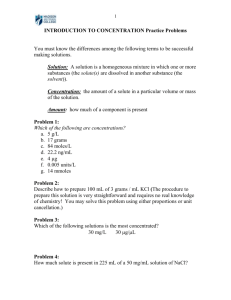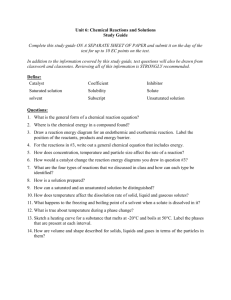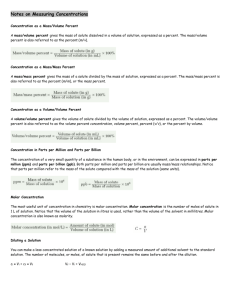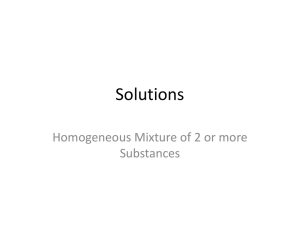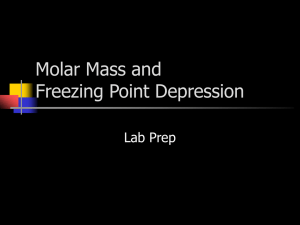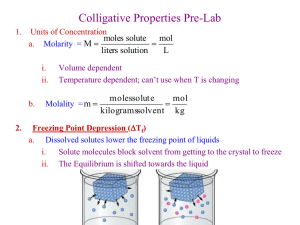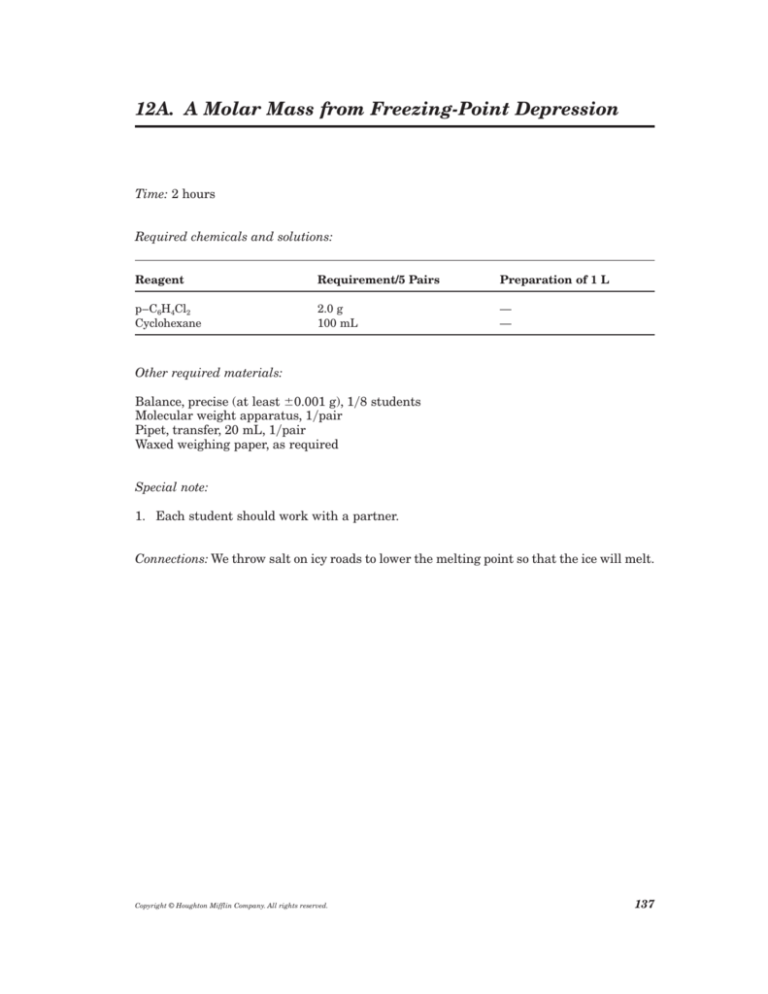
12A. A Molar Mass from Freezing-Point Depression
Time: 2 hours
Required chemicals and solutions:
Reagent
Requirement/5 Pairs
Preparation of 1 L
p–C6H4Cl2
Cyclohexane
2.0 g
100 mL
—
—
Other required materials:
Balance, precise (at least 0.001 g), 18 students
Molecular weight apparatus, 1pair
Pipet, transfer, 20 mL, 1pair
Waxed weighing paper, as required
Special note:
1. Each student should work with a partner.
Connections: We throw salt on icy roads to lower the melting point so that the ice will melt.
Copyright © Houghton Mifflin Company. All rights reserved.
137
A Molar Mass from Freezing-Point Depression
Date:
........................................................................
Student name:
..................................................................................................
Course:
........................................................................
Team members:
..................................................................................................
Section:
........................................................................
..................................................................................................
Instructor:
........................................................................
..................................................................................................
Prelaboratory assignment
1. Provide definitions for the following terms:
a. Solution
A homogeneous mixture of two or more substances
b. Solute
A substance that dissolves in a liquid
c.
Solvent
The liquid in which a solute is dissolved
d. Colligative property
A property that depends on the concentration of molecules or ions in solution rather than on particular
characteristics of the molecular or ionic substance
e. Freezing-point depression
The effect of a solute on the freezing point of a solvent. The freezing-point depression is proportional to
the molal concentration of the solute.
2. a. What is the objective of this experiment?
To determine the molar mass of a solute and its molecular formula
b. How will that objective be achieved?
By finding the freezing-point depressions of solutions of the solute in cyclohexane
138
Copyright © Houghton Mifflin Company. All rights reserved.
A Molar Mass from Freezing-Point Depression
139
3. A 0.2080 g sample of an unknown substance was dissolved in 20.0 mL of
cyclohexane. The density of cyclohexane is 0.779 gmL. The freezingpoint depression was 2.1C. Calculate the molar mass of the unknown
substance.
Tf Kf cm, where Tf 2.1C and Kf 20.5C/m
Tf
2.1C
c m K 20.5C/m 0.10 m
f
0.10 mol solute/kg solvent 20.0 mL solvent
0.779 g solvent/mL solvent 1 kg solvent/103 g solvent
1.6 103 mol solute
0.2080 g solute
Mm 1.6 103 mol solute 1.3 102 g/mol
4. What safety rules must be observed during this experiment?
1. No open flames.
2. Do not use your mouth for pipeting.
Copyright © Houghton Mifflin Company. All rights reserved.
A Molar Mass from Freezing-Point Depression
Date:
........................................................................
Student name:
..................................................................................................
Course:
........................................................................
Team members:
..................................................................................................
Section:
........................................................................
..................................................................................................
Instructor:
........................................................................
..................................................................................................
Results
1. Volume of cyclohexane:
20.0
mL
........................
Mass of cyclohexane:
15.6
........................
g or 0.0156 kg
............................
Calculations:
20.0 mL 0.779 g/mL 15.6 g
15.6 g 1 kg/1000 g 0.0156 kg
140
Copyright © Houghton Mifflin Company. All rights reserved.
A Molar Mass from Freezing-Point Depression
141
2. Freezing point of cyclohexane
Trial 1
Trial 2
Time
Temperature (C)
Time
..................................
0
..................................
14.5
..................................
0
............................................
..................................
15
..................................
12.7
..................................
15
............................................
..................................
30
..................................
11.0
..................................
30
............................................
..................................
45
..................................
9.7
..................................
45
............................................
..................................
60
..................................
8.6
..................................
60
............................................
..................................
75
..................................
7.6
..................................
75
............................................
..................................
90
..................................
7.3
..................................
90
............................................
..................................
105
..................................
6.7
..................................
105
............................................
..................................
120
..................................
6.5
..................................
120
............................................
..................................
135
..................................
6.5
..................................
135
............................................
..................................
150
..................................
6.5
..................................
150
............................................
..................................
165
..................................
6.5
..................................
165
............................................
..................................
180
..................................
6.5
..................................
180
............................................
..................................
195
..................................
6.5
..................................
195
............................................
..................................
210
..................................
6.5
..................................
210
............................................
..................................
225
..................................
6.5
..................................
225
............................................
..................................
240
..................................
6.5
..................................
240
............................................
..................................
..................................
..................................
............................................
..................................
..................................
..................................
............................................
..................................
..................................
..................................
............................................
Freezing point of cyclohexane:
6.5
First trial
6.5
Second trial
6.5
Mean
........................
........................
........................
Copyright © Houghton Mifflin Company. All rights reserved.
Temperature (C)
14.4
12.6
11.5
10.5
9.5
8.7
7.9
7.4
6.9
6.5
6.5
6.5
6.5
6.5
6.5
6.5
6.5
142 Experiment 12A
3. Freezing points of the solutions
Sample
1
2
Mass of paper solute (g)
....................................
0.6782
..................................
0.5443
Mass of paper (g)
....................................
0.4276
..................................
Mass of solute (g)
....................................
0.2506
..................................
0.4431
0.1012
Samples 1 2
Sample 1
Time
Temperature (C)
Time
Temperature (C)
..................................
0
..................................
14.7
..................................
0
..................................
..................................
15
..................................
10.7
..................................
15
..................................
..................................
30
..................................
7.1
..................................
30
..................................
..................................
45
..................................
5.8
..................................
45
..................................
..................................
60
..................................
4.7
..................................
60
..................................
..................................
75
..................................
4.1
..................................
75
..................................
..................................
90
..................................
3.9
..................................
90
..................................
..................................
105
..................................
3.9
..................................
105
..................................
..................................
120
..................................
3.8
..................................
120
..................................
..................................
135
..................................
3.8
..................................
135
..................................
..................................
150
..................................
3.7
..................................
150
..................................
..................................
165
..................................
3.5
..................................
165
..................................
..................................
180
..................................
3.3
..................................
180
..................................
..................................
195
..................................
3.3
..................................
195
..................................
..................................
210
..................................
3.2
..................................
210
..................................
..................................
225
..................................
3.1
..................................
225
..................................
..................................
240
..................................
3.0
..................................
240
..................................
..................................
255
..................................
2.8
..................................
255
..................................
..................................
..................................
..................................
..................................
..................................
..................................
..................................
..................................
13.9
10.2
6.4
4.9
4.0
3.2
3.0
3.0
3.0
2.8
2.5
2.2
2.1
2.0
2.0
2.0
1.8
1.5
Copyright © Houghton Mifflin Company. All rights reserved.
A Molar Mass from Freezing-Point Depression
143
Freezing points of solutions:
Sample 1:
4.2
..........................................
C; Tf 1.5 102
..........................................
2.3
C; Mm ..........................................
3.1
C; Mm ..........................................
Samples 1 2:
3.4
..........................................
Mean Mm:
C; Tf ..........................................
1.5 102
1.5 102
..........................................
Calculations:
Sample 1:
Tf
2.3C
cm K 20.5C/m 0.11 m
f
0.11 mol solute/kg solvent 20.0 mL solvent 0.779 g solvent/mL
solvent 1 kg solvent/103 g solvent 1.7 103 mol solute
Mm 0.2506 g
1.5 102 g/mol
3
1.7 10 mol
Sample 2:
Tf
3.1C
cm K 20.5C/m 0.15 m
f
0.15 mol solute/kg solvent 20.0 mL solvent 0.779 g solvent/mL
solvent 1 kg solvent/103 g solvent 2.3 103 mol solute
0.3518 g
Mm 1.5 102 g/mol
3
2.3 10 mol
Record Mm from your classmates (include your value).
1.5 102 1.4 102 1.4 102
..........................................
..........................................
..........................................
1.4 10
..........................................
..........................................
2
..........................................
1.7 10
..........................................
..........................................
..........................................
..........................................
..........................................
1.5 10
..........................................
..........................................
..........................................
..........................................
..........................................
..........................................
..........................................
..........................................
..........................................
2
..........................................
..........................................
Grand average:
1.4 10
2
2
1.4 102 1.6 102
..........................................
..........................................
1.3 10
2
1.5 10
2
..........................................
Copyright © Houghton Mifflin Company. All rights reserved.
144 Experiment 12A
Molecular formula:
C6H4Cl2
Calculations:
The formula weight of C3H2Cl is 73.5. The number of
C3H2Cl units in the molecule is
1.5 102
73.5 2.0
Therefore, the molecular formula is (C3H2Cl)2, or
C6H4Cl2.
Questions
1. What would be the effect of each of the following on the calculated
molecular weight of the solute? Think carefully!
a. Some cyclohexane evaporated while the freezing point of pure
cyclohexane was being measured.
Of course, the freezing point of pure cyclohexane is
not affected. However, the freezing point of the solution will be lower than it should be. As a result,
Tf will be larger than it should be. The calculated
value of cm and the moles of solute will then be too
large. The molar mass of the solute will be too small
because its mass will not be altered, but the number of moles will be too large.
b. Some cyclohexane evaporated after the solute was added.
Same effects as noted in part a after the solute
was added
Copyright © Houghton Mifflin Company. All rights reserved.
A Molar Mass from Freezing-Point Depression
145
c. A foreign solute was already present in the cyclohexane.
Although a foreign solute alters the appearance of
the cooling curve for pure cyclohexane, Tf for the
solute being measured should not change. As a result, there is no effect.
d. The thermometer is not calibrated correctly. It gives a temperature
that is 1.5C too low at all temperatures.
There is no effect because Tf is still correct.
Copyright © Houghton Mifflin Company. All rights reserved.

